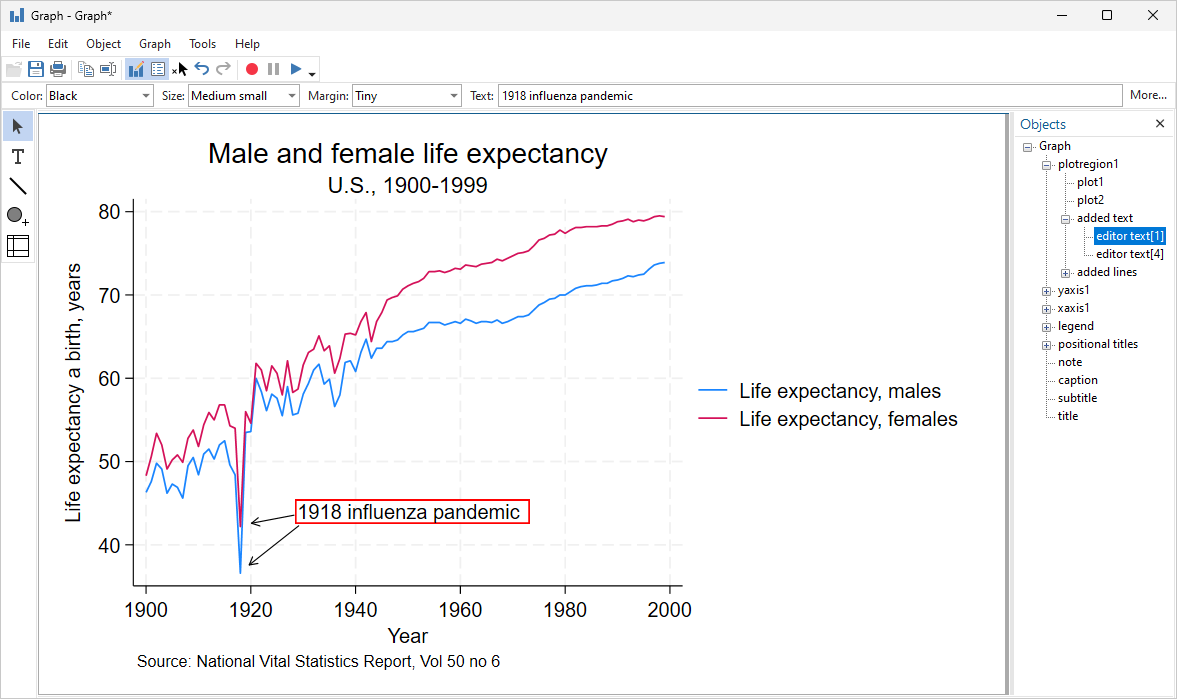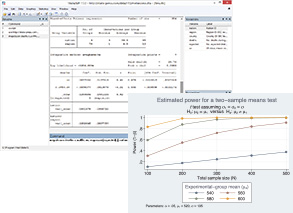
Survey methods
Whether your data require a simple weighted adjustment because of differential
sampling rates or you have data from a complex multistage survey, Stata's
survey features can provide you with correct standard errors and confidence
intervals for your inferences.
Simply specify the relevant characteristics of
your sampling design, such as sampling weights (including weights at multiple
stages), clustering (at one, two, or more stages), stratification, and
poststratification. After that, most of Stata's estimation commands can adjust
their estimates to correct for your sampling design.
Multiple imputation
Account for missing data in your sample using multiple imputation. Choose from
univariate and multivariate methods to impute missing values in continuous,
censored, truncated, binary, ordinal, categorical, and count variables.
Then, in a single step, estimate parameters using the imputed datasets, and combine
results. Fit a linear model, logit model, Poisson model, multilevel model,
survival model, or one of the many other supported models. Use the mi command,
or let the Control Panel interface guide you through your entire MI analysis.
Multilevel mixed-effects models
Whether the groupings in your data arise in a nested fashion (students nested
in schools and schools nested in districts) or in a nonnested fashion (regions
crossed with occupations), you can fit a multilevel model to account for the
lack of independence within these groups.
Fit models for continuous, binary,
count, ordinal, and survival outcomes. Estimate variances of random
intercepts and random coefficients. Compute intraclass correlations. Predict
random effects. Estimate relationships that are population averaged over the
random effects.
Panel data
Take full advantage of the extra information that panel data provide while
simultaneously handling the peculiar difficulties that panel data present.
Study the time-invariant idiosyncratic features within each panel, the
relationships across panels, and how outcomes of interest change over time.
Fit linear models or nonlinear models for binary, count, ordinal, censored,
or survival outcomes with fixed-effects, random-effects, or population-averaged
estimators. Fit dynamic models or models with endogeneity. Fit Bayesian panel-data models.
Meta-analysis
Combine results of multiple studies to estimate an overall effect. Use
forest plots to visualize results. Use subgroup analysis and
meta-regression to explore study heterogeneity. Use funnel plots and
formal tests to explore publication bias and small-study effects. Use
trim-and-fill analysis to assess the impact of publication bias on
results. Perform cumulative and leave-one-out meta-analysis. Perform
univariate, multilevel, and multivariate meta-analysis. Use the meta suite, or let the Control Panel interface
guide you through your entire meta-analysis.
Linear, binary, and count regressions
Fit classical linear models of the relationship between a continuous outcome,
such as wage, and the determinants of wage, such as education level, age,
experience, and economic sector. If your response is binary (for example,
employed or unemployed), ordinal (education level), or count (number of
children), don't worry.
Stata has maximum likelihood estimators—probit,
ordered probit, Poisson, and many others—that estimate the relationship
between such outcomes and their determinants. A vast array of tools is
available to analyze such models. Predict outcomes and their confidence
intervals. Test equality of parameters or any linear or nonlinear combination
of parameters.
Structural equation modeling (SEM)
Estimate mediation effects, analyze the relationship between an unobserved
latent concept such as a person's level of conservatism and the observed
variables that measure conservatism, model a system with many endogenous
variables and correlated errors, or
fit a model with complex relationships among both latent and observed variables.
Fit models with continuous,
binary, count, ordinal, fractional, and survival outcomes. Even fit
multilevel models with groups of correlated observations such as children
within the same schools. Evaluate model fit. Compute indirect and total
effects. Fit models by drawing a path diagram or using the straightforward
command syntax.
Adjusted predictions, interactions, and moderation
Adjusted predictions and marginal means let you analyze the relationships
between your outcome variable and your covariates, even when that outcome is
binary, count, ordinal, or categorical. Compute adjusted predictions with
covariates set to interesting or representative values.
Or compute marginal means for each level of a categorical covariate. Make comparisons of the
adjusted predictions or marginal means using contrasts. If you have
multilevel or panel data and random effects, these effects are automatically
integrated out to provide marginal (that is, population-averaged) estimates.
After fitting almost any model in Stata, analyze the effect of moderating
variables, and easily create interaction plots.
Choice Models
Model your discrete choice data. If your outcome is, for instance,
high-school graduates' choices to attend college, attend a trade
school, or to work, you can fit a conditional logit, multinomial
probit, or mixed logit model. Is your outcome instead a ranking of
prefered alternatives?
Fit a rank-ordered probit or rank-ordered
logit model. Regardless of the model fit, you can use the
margins to easily interpret the results. Estimate how much
distance to the nearest college affects the probability of
enrolling in college and even the probability of going to
a trade school.
Bayesian analysis
Fit Bayesian regression models using one of the Markov chain Monte Carlo
(MCMC) methods. You can choose from various supported models or even
program your own. Extensive tools are available to check convergence,
including multiple chains. Compute posterior mean estimates and credible
intervals for model parameters and functions of model parameters. You
can perform both interval- and model-based hypothesis testing. Compare
models using Bayes factors. Compute model fit using posterior predictive
values and generate predictions. If you want to account for model
uncertainty in your regression model, use
Bayesian model averaging.
Causal inference
Estimate experimental-style causal effects from observational data. With
Stata's treatment-effects estimators, you can use a potential-outcomes
(counterfactuals) framework to estimate, for instance, the effect of
family structure on child development or the effect of unemployment on
anxiety. Fit models for continuous, binary, count, fractional, and
survival outcomes with binary or multivalued treatments using
inverse-probability weighting (IPW), propensity-score matching,
nearest-neighbor matching, regression adjustment, or doubly robust
estimators. If the assignment to a treatment is not independent of the
outcome, you can use an endogenous treatment-effects estimator. In the
presence of group and time effects, you can use
difference-in-differences (DID) and triple-differences (DDD) estimators.
In the presence of high-dimensional covariates, you can use lasso. If
causal effects are mediated through another variable, use causal
mediation with mediate to
disentangle direct and indirect effects.
Programming
Want to program your own commands to perform estimation,
perform data management, or implement other new features?
Stata is programmable, and thousands of Stata users have
implemented and published thousands of community-contributed commands.
These commands look and act just like official Stata commands
and are easily installed for free over the Internet from within
Stata. A unique feature of Stata's programming environment is Mata,
a fast and compiled language with support for matrix types. Of course, it has
all the advanced matrix operations you need. It also has access to
the power of LAPACK. What's more, it has built-in solvers and optimizers
to make implementing your own maximum likelihood, GMM, or other
estimators easier. And you can leverage all of Stata's estimation and
other features from within Mata. Many of Stata's official commands are
themselves implemented in Mata.
Automated reporting and customizable tables
Stata is designed for reproducible research, including the ability to
create dynamic documents incorporating your analysis results. Create
Word or PDF files, populate Excel worksheets with results and format
them to your liking, and mix Markdown, HTML, Stata results, and Stata
graphs, all from within Stata. Create tables that compare regression results or summary statistics, use default styles
or apply your own, and export your tables to Word, PDF, HTML, LaTeX,
Excel, or Markdown and include them in your reports.
Jupyter Notebook with Stata
Jupyter Notebook is widely used by
researchers and scientists to share their ideas and results for collaboration
and innovation. It is an easy-to-use web application that allows you to
combine code, visualizations, mathematical formulas, narrative text, and other
rich media in a single document (a "notebook") for interactive computing and
developing. You can invoke Stata and Mata from Jupyter Notebook with the
IPython (interactive Python) kernel. This
means you can combine the capabilities of both Python and Stata in a single
environment to make your work easily reproducible and shareable with others.
Most impressive is the fact that you guys find fixes for every problem or question that we have, quickly and efficiently. And little by little, as Stata develops, we are dropping the other programs we use, too. I don't know of any other software company that responds as well to its users' questions, suggestions, and comments. Great work!
— Julien Teitler
Department of Sociology, University of Pennsylvania
Intuitive and easy to use.
Once you learn the syntax of one estimator, graphics command,
or data management tool, you will effortlessly understand the rest.
Accuracy and reliability.
Stata is extensively and continually tested. Stata's tests produce
approximately 5.8 million lines of output. Each of those lines is
compared against known-to-be-accurate results
across editions of Stata and every operating system Stata supports to
ensure accuracy and reproducibility.
One package. No modules.
When you buy Stata, you obtain
everything for your statistical,
graphical, and data analysis needs. You do not need to buy separate modules
or import your data to specialized software.
Write your own Stata programs.
You can easily write your own Stata programs and commands. Share them
with others or use them to simplify your work. Utilize Stata's
do-files, ado-files, and Mata: Stata's own advanced programming
language that adds direct support for matrix programming. You can also
access and benefit from the thousands of existing Stata
community-contributed programs.
Extensive documentation.
Stata offers 35 manuals with more than 18,000 pages of PDF documentation
containing detailed examples, in-depth discussions, references to relevant literature,
and methods and formulas. Stata's documentation is a great place to learn about
Stata and the statistics, graphics, data management, and data science tools you
are using for your research.
Top-notch technical support.
Stata's technical support is known for their prompt, accurate,
detailed, and clear responses. People answering your questions have master's
and PhD degrees in relevant areas of research.
Join us for one of our free live webinars. Ready. Set. Go Stata shows you how to quickly get started manipulating, graphing, and analyzing your data. Or, go deeper in one of our special-topics webinars.

Stata's YouTube has over 300 videos with a dedicated playlist of methodologies important to your work in sociology. And they are a convenient teaching aid in the classroom.

Get started quickly at using Stata effectively, or even learn how to perform rigorous time-series, panel-data, or survival analysis, all from the comfort of you home or office. NetCourses make it easy.
Stata Press offers books with clear, step-by-step examples that make teaching easier and that enable students to learn and sociologists to implement the latest best practices in analysis.